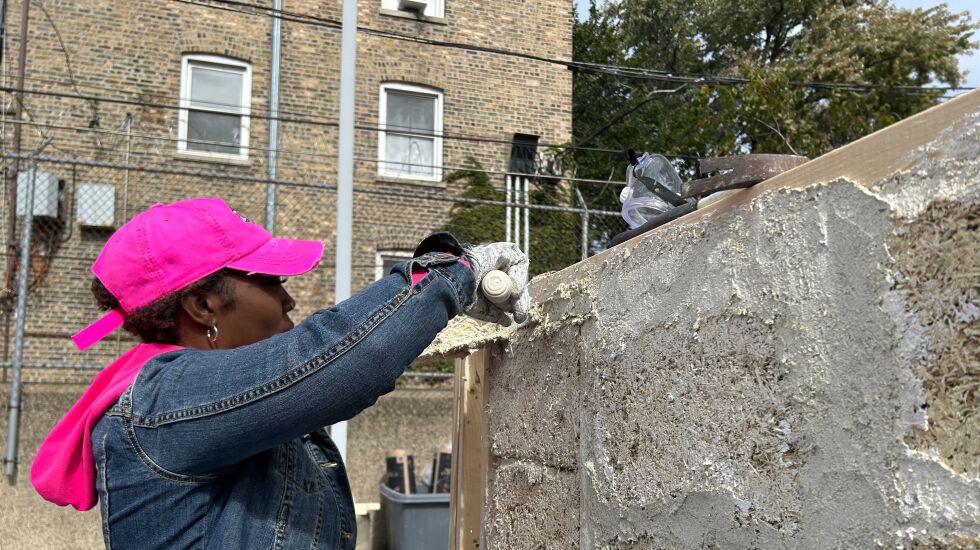
As a mason with asthma and bronchitis, every time Larry Hill buys a new building he has to tear out and redo the interior.
“I don’t know what’s in there. I can’t breathe in there. A lot of these houses got so much mold and stuff in there,” Hill said.
After spending the last four days at a green building workshop learning about hempcrete, Hill wants to start using the natural, nontoxic building material, starting with a garage he’s building at his house.
Hempcrete is a breathable, sustainable building material made from the woody interior of the hemp stalk. Unlike modern concrete, hempcrete is modeled off ancient Roman concrete, and rather than increasing carbon emissions, hempcrete pulls it from the atmosphere.
“I think this is the future. It’s historical. I mean they did it years and years ago,” Hill said. “It’s like lost and come back.”
About 50 investors, students, architects, workers in the trades and farmers participated in a multiday workshop focusing on the uses of hemp as an industrial product.
The Building Green Hempcrete Workshop, led by Chicago-based Pink Hats Construction and Development Group and Toronto-based Eleven 11 Farms, had more than a dozen sponsors from around the continent.
Hempcrete is not a direct replacement for modern concrete but has many other uses, including insulation, wallboard and partition walls. As an industrial material, hemp can also be used in textiles and flooring, among other uses.
“It was important for me, as a minority-owned construction company, to be able to bring this here to the Midwest,” said Traci Quinn, CEO of Pink Hats Construction.
She said she wants to be a “catalyst to spearhead green living” in Illinois to help achieve the state’s goal of reaching 100% clean energy by 2050. Because hempcrete absorbs energy, it can generate carbon credits.
Hempcrete does have some drawbacks, including that it cannot be used for load-bearing walls, is not readily available and requires skill sets that may be unfamiliar to workers, a 2022 study published in Science Direct found.
Hemp’s availability and the skill set for working with hempcrete were subjects of the workshop, Quinn said. While Pink Hats Construction is a licensed grower in Illinois, Quinn said it isn’t growing the product yet. But she hopes to work with local farmers to use hemp to revive their soil between crop seasons.
“It’s a great turnover for corn and soy farmers, when they remediate their land after harvest, to grow hemp for a year. It absorbs all of the carbon, all of the metals out of the soil,” she said.
The U.S. industrial hemp market is relatively new, said Tim White, president of Texas Healthy Homes, one of the event’s sponsors. He said hemp has only been legal to grow for industrial purposes in the U.S. for four or five years, and now most of the hemp used still has to be imported.
White said people traveled from around the country for the workshop.
“What in the world are we doing here in Chicago?” White said. “We’re committed to making a difference in the world, making a positive difference in the world, and that’s where we come from, and we’re trying to promote it in different areas.”
In addition to its ability to draw carbon out of the atmosphere and soil, hempcrete is also zero-waste because any material generated during construction can be reused.
Quinn said a major benefit is its protection against fires.
“Maui, they’re starting to build. They reached out to me to see what we can do to help build some temporary homes there. Why? Because it’s smokeproof and a fire retardant,” she said.
For participants like Melvin Henley, CEO and president of the construction company PAC Leaders, the workshop provided not only skills to use hempcrete in construction but also to train others.
He said the information is invaluable and will enable him to bring this into future projects.
“Understanding that there’s a way that we can build green and train to build green, I think that really made us want to focus on this,” Henley said.
Workshop participant Laura Felix is a student in St. Augustine College’s construction pre-apprenticeship program.
She said she was grateful to learn about hempcrete and plans to share what she learned with her classmates.
“No one really is teaching us this. It was a great opportunity,” Felix said. “It’s not something that we’re exposed to on the daily.”
Gude Bernardez came to the workshop with her husband, who is an investor in hemp processing in South Carolina. She said she was amazed by the material.
“I’m from Mexico originally, so I’m thinking just to bring this to Mexico, too, and educate people, because sometimes they say hemp is synonymous of marijuana, and that’s not true,” Bernardez said.
“My mind is spinning right now about ideas on how to introduce this to other people,” she said.







